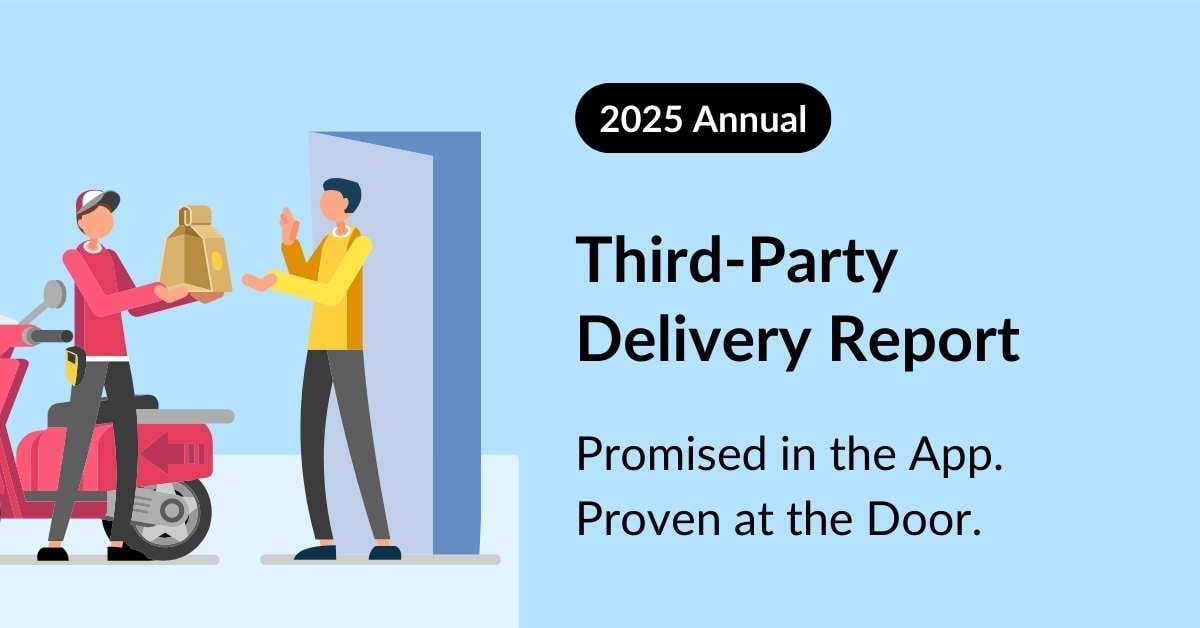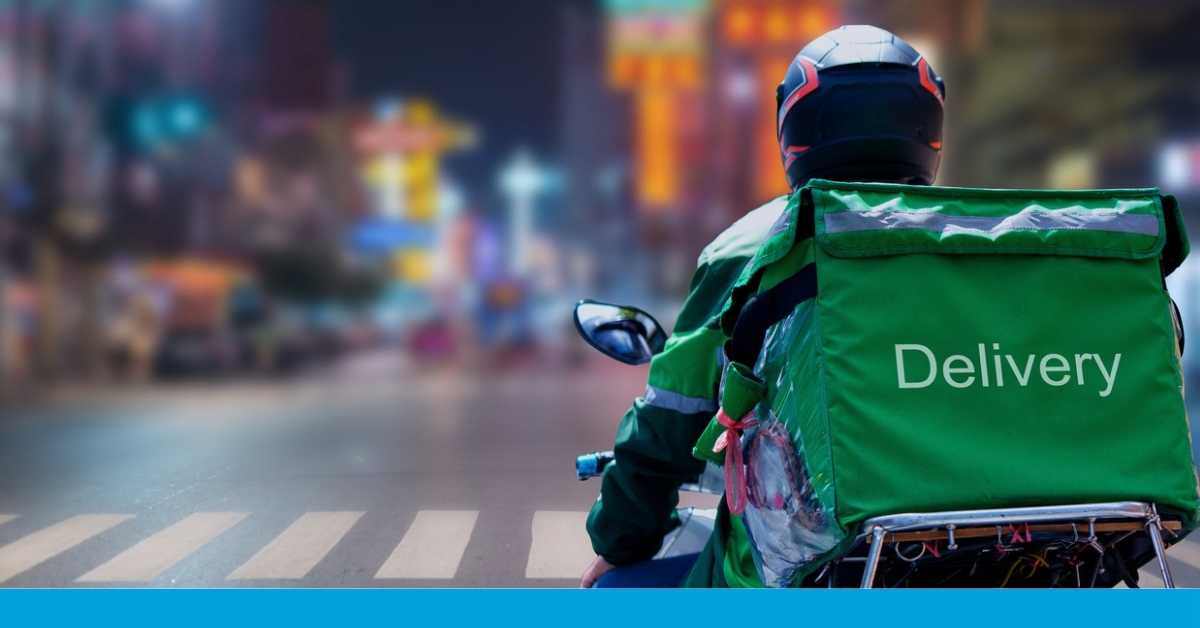Restaurants vs. C-Stores in Food Delivery
Delivery used to be a restaurant advantage, but new players are now competing on speed and pricing, challenging what diners expect when they order a...
4 min read
 Sarah Beckett
September 18, 2025
Sarah Beckett
September 18, 2025

Having food delivered fresh to your door was once a novelty. Today the conversation steers toward speed, accuracy, temperature, satisfaction, and every detail that shapes the perfect delivery experience.
Now, the industry has reached a crossroads. Third-party delivery stormed the market with convenience and opportunity for restaurants and c-stores alike. But first-party solutions have since gained considerable interest, blurring the lines and raising a bigger question:
What is the right path forward?
Our latest report, the 2025 Third-Party Delivery Study dives into the real-world performance of leading channels including Uber Eats, DoorDash, and Grubhub. And for the first time, we've included First-Party Delivery in our analysis, offering a fresh benchmark against third-party platforms.
Through data from 600 mystery shops across the United States from April to June 2025, we captured the elusive space between what the app promises and what the customer gets. 150 orders were placed on each third-party platform: Uber Eats, DoorDash, and Grubhub, along with 150 through first-party brand apps. Orders were placed between 5:00 a.m. and 11:00 p.m. and evenly split between restaurants and convenience stores.
Let’s unwrap the key findings.
Fast delivery times, strong accuracy, and more control over order customization, first-party channels showed that operators are serious about owning the relationship. In fact, their average delivery clocked in at just under 31 minutes, faster than much of the third-party competition, and they reached 90% order accuracy, the highest in the study.
But the picture isn’t as simple as “in-house equals better.” Many “first-party” orders were still passed off to third-party drivers. Customers rarely noticed the handoff distinction, but they absolutely held the brand accountable for what arrived at their door.
Our comparisons didn’t stop there. We went the whole mile to discover where first-party delivery is gaining ground in both restaurants and convenience stores. Read our latest study for the whole breakdown.

A quoted time is a direct promise to the customer. This year, platforms aimed to rebuild customer confidence by shortening their average promoted delivery time by one minute, from 38m 11s to 37m 11s. But not every brand moved in sync. DoorDash and Grubhub both increased their promoted times, aiming for more conservative windows, yet even with longer lead times, both saw an increase in late arrivals.
The “wait window” has been one of the most telling third-party delivery trends. Deliveries that went straight to the customer arrived 8 minutes and 5 seconds faster than those that were batched with other orders. When routes included multiple drop-offs, meals were not only slower to arrive but also more likely to show up at the wrong temperature, with satisfaction scores dipping sharply. It’s a reminder that delivery is about distance, but also about sequencing. And that final leg of the journey may matter more than all the logistics before it.
Shopper quote: “The delivery took longer than I was told it would. The food was almost cold and did not taste good.”
A delivery is only a success if the order is correct…In every aspect.
The moment a customer opens that bag is a true test of trust. While order accuracy improved overall, over 1 out of 10 orders still had something a customer considered inaccurate. Orders that were accurate had a 45-point higher satisfaction rate than those that were inaccurate.
What’s more?
One of the clearest third-party delivery trends is the shrinking gap between restaurant and C-store order accuracy, which dropped from 13 points in 2024 to just 7 points this year.
The third-party delivery trends also revealed how the time of day had a part to play in the shift in data between 2024 and this year. Late night became a weak spot for one of the operators, showing an order accuracy drop to 70% after 8 p.m. More about the window of opportunity is revealed in our 2025 Third-Party Delivery Study.

Curious how third-party delivery plays out for pizza?
Explore the impact of third-party delivery in the pizza industry.
The final impression matters more than ever. Overall satisfaction with the level of service for third-party platforms saw a small but steady increase of 1% from last year, landing at 86% in 2025. The gap between the top and bottom also narrowed, signaling a tighter race to retain customer trust, with Uber Eats edging ahead to take the top spot this year.
Our report reveals that satisfaction is not a matter of luck; it's a matter of execution. The fundamentals matter most. Accurate orders pushed satisfaction to a rate of 93% compared to just 48% satisfaction when they were inaccurate. Meals that arrived at the right temperature drove overall satisfaction too, with a 42-percentage point jump. We also uncovered a clear sweet spot in delivery time that correlated with higher satisfaction. Curious to find out? Read our latest report for the details.
Restaurants vs. C-Stores: In 2024, restaurants had an 11-point lead over C-store foodservice in overall satisfaction, but our 2025 data shows that margin has shrunk.
Shopper Quote: “The delivery was dropped off earlier than expected. I appreciated that the driver did not deliver another order first.”
Delivery has always come with a price, and fees are a key factor affecting perception. Our data shows the industry responded to "fee fatigue," as the average delivery fee across all third-party platforms dropped by $1.10 from last year.
First-party apps took a completely different approach. While some carried higher delivery fees, they offset the hit with lower service charges, resulting in a competitive total fee.
Combo deals, loyalty rewards, and transparent pricing all help soften the sting of fees. In an environment where 80% of customers say affordability affects their likelihood to order, value isn’t just a selling point; it’s survival.
Other metrics evaluated in the study: Order customization, daypart breakdowns, application ease of use, order personalization, and more.
Food delivery has outgrown novelty. It is now a test of trust, precision, and value. And every delivery is a direct reflection of your brand.
The 2025 third-party delivery trends show how much has shifted: first-party apps gaining ground, platforms racing to meet their own ETAs, operators striving for accuracy and temperature, and customers pushing back on fees.
The full study unpacks these shifts in detail, with platform-by-platform comparisons, restaurant vs. c-store insights, and year-over-year trends you will not want to miss.
Do you want to see where your biggest opportunities lie?
Continue exploring this three-part blog series on the Third-Party Delivery study.
| Next: What the Data Says About In-House (First-Party) Delivery vs. Third-Party

Delivery used to be a restaurant advantage, but new players are now competing on speed and pricing, challenging what diners expect when they order a...

Scroll through a delivery app today, and the customer relationship clearly sits with third-party giants. Uber Eats. DoorDash. Grubhub. They’ve shaped...

Pizza delivery has come a long way from a simple phone call and a 30-minute wait. Today, customers expect speed, accuracy, and a hot, fresh pizza...